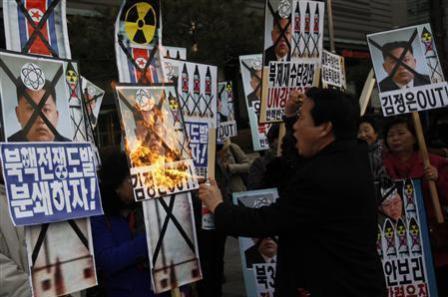VIENNA, (Reuters) – North Korea’s nuclear test may be aimed at showing its foes it can deliver a missile with a warhead but it is still a long way from being able to threaten the United States, experts said.
The Comprehensive Nuclear Test Ban Treaty Organisation (CTBTO), an international monitoring agency, said an explosion-like event that North Korea described as a nuclear test had a magnitude of 4.9. This was bigger than similar tests it carried out in 2006 and 2009.

REUTERS/Kim Hong-Ji
CTBTO executive secretary Tibor Toth said the action “constitutes a clear threat to international peace and security and challenges efforts to strengthen global nuclear disarmament and non-proliferation”.
North Korea said the test, which drew swift international condemnation, had used a miniaturized device.
If it was such a device, “that suggests a weapon that could more easily be delivered by missiles, something that is especially concerning to the U.S., Japan, South Korea and others,” said Shashank Joshi, a senior fellow at the Royal United Services Institute.
Nuclear proliferation expert Mark Fitzpatrick of the International Institute for Strategic Studies in London said: “It won’t be possible to confirm from afar, but the claim of a successful miniaturized device is consistent with expectations that the test would be of a warhead that can fit in the nose cone of one of its missiles.”
Jim Walsh of Massachussets Institute of Technology said: “It seems as if Pyongyang wants to send the message – true or not – that it can employ a missile with a nuclear warhead and that previous problems with their nuclear tests have been overcome.”
However, North Korea still had a long way to go before it could credibly threaten the United States with nuclear weapons, said Daryl Kimball from the Arms Control Association, a U.S.-based research and advocacy group.
“It is likely to be years away from fielding an ICBM, which could deliver a nuclear warhead to the U.S. mainland. There is still time to halt and reverse current trends before North Korea’s nuclear capabilities become more substantial.”
NO LIES ON TEST
An international test-ban treaty was negotiated in the 1990s but has not yet taken effect because not all holders of nuclear technology have ratified it. The Vienna-based CBTBO monitors possible breaches, looking out for signs of atomic tests, including seismic waves and radioactive traces.
Experts say it can take days or more to detect possible radioactive signs that would confirm with absolute certainty that a nuclear test had taken place.
Seen as a cornerstone of efforts to free the world of atomic bombs, the test ban treaty enjoys wide support around the world. But of the five officially recognised nuclear weapon states, the United States and China have yet to ratify it.
“Though confirmation will take some time, given the seismic signature and the important fact (North Korea) has never lied when it comes to nuclear tests, I think we can take them at their word and assume this was the explosion of a nuclear device,” a Western diplomat in Vienna said.
Kimball also said the test was an embarrassment for China’s leadership and Pyongyang may have jeopardized the aid and diplomatic support it receives from Beijing.
China criticised the previous tests but did not roll back on aid. But Beijing had signaled that if North Korea undertook further tests, it would not hesitate to reduce assistance.
“Indeed, Beijing could do much more to apply pressure. Past Chinese diplomatic and economic support has allowed North Korea to ignore world opinion, in spite of the desperate state of its economy and hunger-ravaged population. It is important that Beijing now demonstrate its last warning was sincere,” Kimball said.
